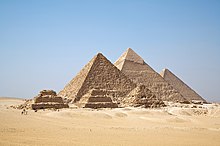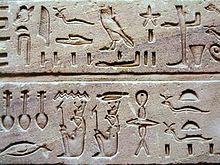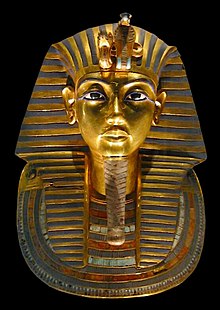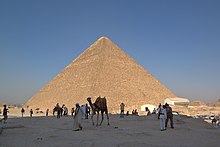Wikijunior:Ancient Civilizations/Egyptians
What country did they live in?
[edit | edit source]

Egypt is in northeastern Africa. The Ancient Egyptians lived along the River Nile, the "fertile river." This river flows from the central part of Africa. The Nile's water flows north and empties into the Mediterranean Sea. At the northern most part of the Nile, the Nile forms a delta. The delta is the wider, triangular mouth of river, where it leaves behind dirt and other sediment.
The Nile was very important to life in Egypt. Seasonal floods every year covered the land near the river with fresh silt, making the land very good for growing food. In order to grow more food, people built irrigation canals to move water from the river to nearby areas. The Sahara Desert makes up much of the surrounding area, so most people didn't travel very far from the Nile. The surrounding desert land made the rich soil of the Nile very important for growing crops.
Egyptian transportation systems included boats that traveled north and south along the river. Boats could easily travel north, with the current of the river, but they could go south easily as well. The winds along the river usually blew to the south, so the Egyptians would raise sails on their boats and head against the current with the help of the wind!
The Greek historian Herodotus traveled the river thousands of years after the Egyptians started their civilization. He is often quoted as saying that "Egypt is the gift of the Nile." This means that, without the Nile, civilization in Egypt would be impossible.
What did their buildings look like?
[edit | edit source]

There were two types of buildings that the ancient Egyptians lived in. One was called the worker's home. The other was the town house, which was for wealthier people. Both types of houses were built from bricks. Stone was only used for building permanent structures, such as the Pyramids. The bricks were made from a mixture of mud, pebbles, and straw. The builders would pour the mixture into wooden frames and leave it in the sun to dry and harden. Buildings made from such bricks eventually crumbled, and new buildings were constructed right on top of the ruins. This led to the formation of tells or hills. Houses were often built along the Nile River, but they had to be high to avoid flooding.
A worker's home was usually one-story high and had up to four rooms. There was a yard and a kitchen in the back of the house, as well as two underground storage cellars. The roofs of the Egyptians houses were flat, and people spent much of their time there. Egyptian families slept, cooked, and ate their meals on the roof. It was a bit like having a living room, kitchen, dining room, and bedroom all up on the roof. The Egyptians did not have running water in their homes, but water could be taken from nearby wells. Workers' homes had very little furniture, including beds and storage chests for clothes.
The houses of the wealthy were much larger and up to three stories tall. Because the walls were much higher, they had to be supported by wooden beams. The walls of the first floor were sometimes made of stone for added strength. Different levels of the house served different purposes. The first floor was where business and work was conducted. The second and third floors were the living space for the family and had nicer furnishings. The roof was used for preparing and cooking meals that were then brought in by the servants. Wealthy homes had gardens, pools, and small shrines for worship. Some houses were decorated with tiled floors, barred windows, fancy staircases, and painted walls. The ceilings were high and held up with columns.
The pyramids were large stone structures built to house the bodies of the Egyptian rulers, or Pharaohs, after they died. The pyramids were built high, because it was believed to be the ruler's staircase to heaven. Although the most famous shape is the familiar three-dimensional triangle, pyramids were built in a variety of shapes. They were all built with the help of simple machines, including pulleys, inclined planes, and levers. The inside walls of the pyramids were decorated with hieroglyphics, the picture-based writing of the Egyptians. The tomb of the Pharaoh was located in a room deep in the heart of the pyramid, and was filled with gold, jewels, and other riches. It was also filled with other everyday objects that might be needed by the dead Pharaoh during his journey to the afterlife. This could include food, clothing, utensils, pottery, and furniture. Sometimes, even servants were sealed up in the tomb! Because of all the treasure inside the tomb, robbers sometimes broke into the pyramids, but their maze-like interior could cause them to get lost and die of starvation. Another defense against robbers were the curses written at the entrance of the pyramids. Most ancient Egyptians were very superstitious, and the curses were frightening enough to keep them away. Unfortunately, as centuries passed, thieves grew less afraid of the curses and managed to steal many of the ancient treasures that had been in the tombs for ages.
What did they eat?
[edit | edit source]The ancient Egyptians ate food that is not much different from what we eat today. Because the Nile River supplied them with a constant water source, the Egyptians were able to grow many different kinds of crops in their desert environment. Common crops included grains, vegetables, and fruit. It was expensive to raise animals. Therefore, most domestic animals were used as work animals rather than as food. Often, Egyptian families hunted wild animals to eat.
The Egyptians ate many different kinds of bread. The dough was made from grain, yeast, eggs, butter, salt, milk, and spices. In early times, it was cooked over an open fire. Later, pre-heated stone slabs were used. The bread could be plain or filled with beans, vegetables, or other ingredients. If sweet bread was desired, it would be flavored with honey, fruit, or dates. Honey was the main sweetener for the Egyptians, because they had not discovered sugar. They also believed that honey had healing properties.
Because the Nile provided lots of water, fruits and vegetables made up a large part of the Egyptian diet. Common vegetables included: cucumbers, onions, cabbage, garlic, radishes, leeks, and more. Green vegetables were often served with a dressing, usually made of vinegar and oil, not unlike the salad dressings we use today. Fruits like figs, pomegranates, dates, melons, and grapes were readily available. Wealthy people could import fruits like coconuts, apples, and peaches.
Fish was also a large part of their diet, although many rich people would not eat it. Fish was usually eaten fried, boiled, or roasted. It was also often sun-dried.
What did they wear?
[edit | edit source]

Most Egyptians wore white tunics made of linen. Linen was by far the most common textile. It helped people to be comfortable in the heat. Linen is made from the flax plant. Plant dyes could be applied to clothing but the clothing was usually left in its natural color. Only the pharaohs or wealthy wore animal skins, from lions or leopards. Clothing made from animals was forbidden in temples and sanctuaries.
Men wore skirts or tunics to the knee. Women would cover their legs and often wore a simple dress called a kalasiris. While working, men wore loincloths, and women wore shorter skirts. Peasants, workers and other people of modest condition often wore nothing. Slaves often worked naked. Wealthier people had pleats in their clothing, and some noblewomen wore beaded dresses.
Egyptians wore sandals made of palm fiber or braided papyrus for shoes. Most people went barefoot and carried their shoes, wearing them only when necessary. Women seldom wore shoes, because most of their work was indoors.
Royalty wore ceremonial clothes which were elaborately decorated with feathers and sequins. The Pharaoh's sandals and gloves were both highly ornamented.
Both men and women wore makeup. They also used a reddish dye called 'henna.' Unlike other ancient civilizations, the Egyptians were quite clean and washed and oiled themselves with scented oil before dressing. They used combs, razors, and tweezers as part of their hygiene routine. Men and women both wore wigs, which were changed every day and made from human hair or wool. Curled wigs were worn on special occasions.
Jewellery was a normal part of any Egyptian's outfit. All classes wore some type of jewelery made of either gold or colorful beads or stones. Lapis lazuli and turquoise were used to make necklaces. Earrings and rings made of clay were also worn as a fashion accessory.
What did they believe?
[edit | edit source]Ancient Egyptians, for most of their history, believed in many gods. Ra, the sun god, was one of the most important gods. Several of the gods were based on animals, or had animals as their symbols. One god was often shown as a jackal and another as a cow.
Often, there were myths told about these gods and goddesses that explained some of the major ideas in ancient Egypt. One famous myth involves Isis and Osiris. This story helped explain several of the most important beliefs, such as the belief in the afterlife.
Egyptians believed that after people died, they went to an afterlife, where they would continue their lives as they lived them on Earth. To do this successfully, however, they had to preserve everything that they had in life on Earth. This is the reason that Pharaohs were buried with everything that they owned. Pharaohs, and others who were rich enough, would have scenes of their life on Earth painted on the walls of their tombs, so that those same sorts of scenes could be relived in the afterlife. This is also why Egyptians believed in mummification: the body had to be preserved, so that the spirit, called the 'ka,' could return to the body after death.
Under the rule of one Pharaoh named Akhenaten, Egypt became monotheist, meaning that they believed in one god. During this time, they worshipped the god Aten, another sun god. Monotheism was never fully embraced by the people of Egypt, however, and after the Pharaoh's death, the Egyptian people went back to polytheism.
What did their writing look like?
[edit | edit source]
The Egyptians had three types of writing. The first is called hieroglyphics. This was a kind of picture writing in which pictures and characters make up words. This can be very hard to read, because the words often run together, and the Egyptians didn’t use punctuation. Another form of writing is called “Hieratic.” This form is the same as hieroglyphics, but written very fast in a cursive style. Last came “Demotic,” which became popular during the time when Egypt was ruled by Pharaohs.
Egyptians could carve hieroglyphs into stone, mud brick, or papyrus (paper made by pounding the stems of a reed until they stick together). Egyptian writing was so difficult that only a very few people learned to read it. If these “scribes” worked very hard, they could become court officials or priests. After Christianity became the religion of the Roman Empire, knowledge of how to speak and write Ancient Egyptian disappeared. In the early 1800s, a large slab of stone with three different forms of writing on it was found. Because it was found near the town of Rosetta in the Egyptian delta, it was called the Rosetta Stone.
Several years later, a man named Jean-François Champollion discovered that one of the languages on the stone was a form of Greek that he knew how to read. The three languages were hieroglyphs, Demotic, and Greek. By gradually comparing common words between the Greek and Egyptian languages, he was able to get a basic understanding of how the ancient Egyptian language worked. However, it has taken the work of many other people to understand Egyptian writing. Even today, there are many signs and words we do not understand. People are still working to put together the puzzle of what all the symbols mean.
Are some of them famous even today?
[edit | edit source]
Yes! King Tutankhamun, sometimes referred to as "King Tut" or "The Boy King", is one of the most well known ancient Egyptian kings in modern times. Interestingly, he was not considered to be very important in ancient times and was not recorded on most ancient king lists. However, the discovery of his tomb in 1922 made him a celebrity. While many tombs of the past were robbed, this tomb was left virtually undisturbed. Most of the items buried with Tutankhamun have been well preserved, including thousands of artefacts made from precious metals and rare stones. This is why he has become so popular in modern times. The discovery of this tomb has allowed historians and archaeologists to have a glimpse of what some of the more important kings may have had in their burial chambers before they were robbed.
Another king, called "Akheonaten" is also famous today. Akhenaten was Tutankhamun's father, and he tried to change the Egyptian religion from many gods to just one god called "Aten", who only the King could worship. This was a very big change for the people of Egypt and may have been unpopular. Akhenaten built a new city called Amarna, but when he died it was abandoned until it was discovered by archaeologists. They were able to see how Egyptians built their cities because it was so well preserved. Egyptologists and historians have argued for many years about why Akhenaten would change the religion that had flourished for thousands of years. Some believe he may have worshipped the "Aten" as his father, Amenhotep III, others think he wanted to make himself more powerful by only allowing the king to worship the god.
What is left of them today?
[edit | edit source]
Even today Egypt is still a major country with a large population. Many modern Egyptians still live near the same land that their ancestors lived on thousands of years ago.
The ancient Egyptians wrote messages that they carved into the wall of many of their buildings, and most of the early work by Egyptologists was based on these writings. Moreover, thousands of papyrus scrolls -- on every aspect of life and many areas of knowledge -- have remained, many still untranslated, to this day. We have much of their art and jewellery as well. Many major pieces were recovered from King Tutankhamen's tomb, and from the tombs of many other Pharaohs. One of the more famous works is the bust of Neffertiti.
Many of the Ancient Egyptians' buildings, tombs and monuments survive, although most are in ruins. Still, there is much to be learned about Egyptian politics, history, religion, and scientific ideas.
